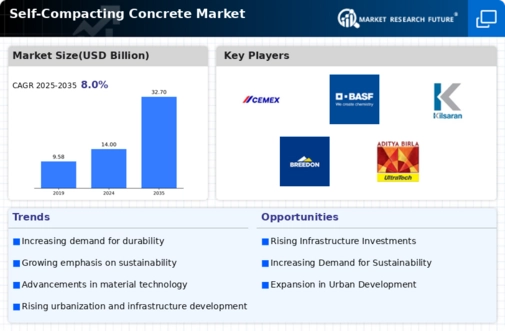Market Analysis
In-depth Analysis of Self Compacting Concrete Market Industry Landscape
The market reality of SCC resembles the colorful synthesis of the different factors that result in the growth and other processes of the SCC market. SCC, which is a concrete of high-performance class that pours and advances steadily without the use of mechanical consolidation puts in action, is a name that is steadily gaining popularity in the building sector. One of the prime factors boosting the market is the increased attention on environmentally-friendly and effective construction techniques, which seek to minimize the weight on natural resources. The growing climate consciousness of the construction industry leads to the appearance of SCC among the other alternatives, since this material factors out a need for vibration aggregate thus it helps decrease the carbon footprint that traditional concrete production produces.
The use of the technology as well as enhancement has a major position that also creates change the competition of the SCC. The research and development of mix designs have constantly been carried out bringing changes in the introduction of additives and superplasticizers which help in the flowability and self-levelling of the concrete. Technological advancement of the SCC not only improves its performance but also opens the way to new application avenues, closing the construction projects' circle with different needs.
The rise and expansion of cities and infrastructures all over the world, as a matter of fact, tends to accelerate the market expansion in the field of SCC. The situation is rapidly changing due to population explosion and urban migration, creating a need for construction technologies that can be put in action and are fast enough to meet the enormous demand. SCC is an outstanding material during difficult job conditions by no means diminishing its accuracy while moving through highly dense reinforcement and filling intricate forms and has a great potential to be used for less time expenditure in modern building projects. In fact, any existing discrepancies during the interplay of traditional construction practices where matters of logistics are involved become more accentuated.
In particular markets, the regulatory authorities also accent the green initiatives for improved sustainable building materials. Environmental authorities at the global level are being characterized by unprecedented regulations causing even the construction firms to acquiesce with the human-friendly practices. SCC as a BB technology can reduce the amount of wastage and also improve the efficiency of construction. This aspect works concurrently with sustainability objectives which should be adopted in various construction projects, leading to the acceptance of SCC.
Nonetheless, the market environment SCC operates within is prone to processing cost challenges. While the first cost might increase when migrating SCC to a regular concrete as the result of downstream event-specific additives and quality control, it nevertheless can be offset by a reduction in service life cycle costs. This expense implication could be a deterrent to the medium or smaller construction projects, or for the areas where the budget constraints are dominant. Moderating the cost disparity among the players through joint research and development, and the utilization of economies of scale is the short-term priority the whole value chain is still taking measures to bridge the market acceptance gap.


 Source: Secondary Research, Primary Research, Market Research Future Database, and Analyst Review
Source: Secondary Research, Primary Research, Market Research Future Database, and Analyst Review





Leave a Comment